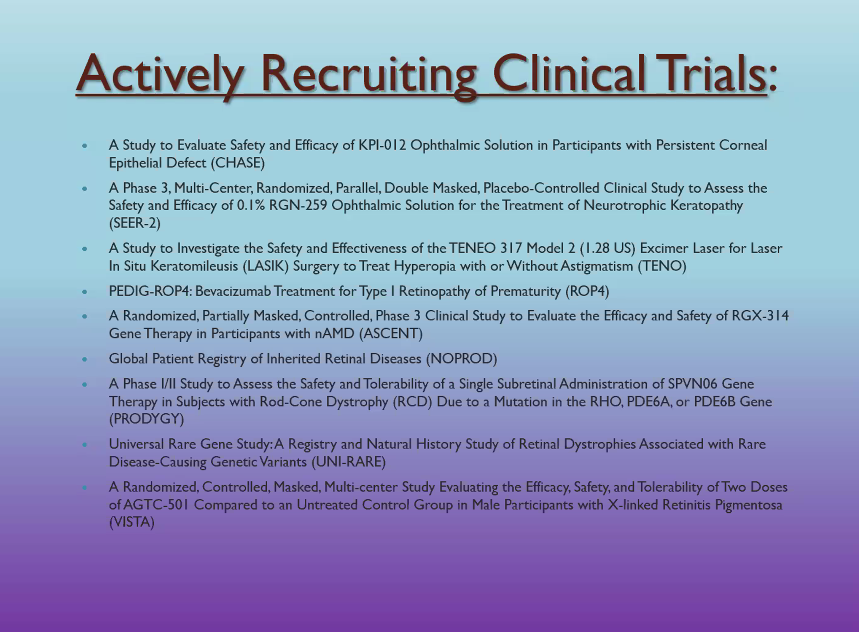Dr. José-Alain Sahel, MD, Distinguished Professor and Chairman of the Department of Ophthalmology and Director of the UPMC Vision Institute, called the topic of the Eye & Ear Foundation’s May 23rd webinar, “Ophthalmology Clinical Trials,” the cornerstone of what the Vision Institute is about. The way research can reach patients and change treatment is through clinical trials, which require specific expertise and a lot of guidance to ensure that patients are not put at risk.
“We want to help them explore the next generation of therapies and benefit from them,” Dr. Sahel said. “We want Pittsburgh to be a place where the most advanced therapies are being developed, tested, and made available to our patients. We are very fortunate because in the new building, we have a dedicated unit for clinical trials.”
Clinical Trials Manager at the Vision Institute, R. Carla Aubourg shared a fun fact: May 20, 2025 was Clinical Trials Day, “a global recognition of clinical research professionals and participants who make life-changing medical progress possible.”
Clinical Trials Contact Information
UPMC Vision Institute
Clinical Trials Wing
1622 Locust St, 5th Floor
Pittsburgh, PA 15219
412-642-7888
clinicaltrialsoph@upmc.edu
Clinical Trials Leadership
Dr. Sahel – Chair
Dr. Jay Chhablani – Vice Chair of Clinical Trials (Retina)
Dr. Vishal Jhanji – Co-Director of Clinical Trials (Cornea)
Dr. Rajesh Sasikumar, Co-Director of Clinical Trials (Glaucoma)
Siobahn Beaton – Director of Operations
Brian Rudolph – Executive Administrator
Clinical Trials Team
The team has three research coordinators, three imaging specialists, one research occupational therapist, one research nurse, one program manager, three Street lab specialists, genetic counselors, pharmacists, and lab specialists.
Some people have been on the team for almost 15-17 years. The research nurse was recruited last year and means patients do not have to leave the building to get their blood drawn or other tests done. All team members are on the same floor, which means easy access to patients. The day before the patient arrives for their clinical trials visit, the team sits together and plans who will do which job. Everything is well structured as soon as the patient walks in, which allows for the best experience possible.
Clinical Trials Department Resources
- 6 dedicated exam rooms (2 exam rooms are longer in length to accommodate for lane certified visual acuity testing)
- 10 rooms dedicated to ophthalmic imaging
- 1 room dedicated to filing study documents
- 1 Street lab
The Street lab is state-of-the-art and the only one on the East coast and in Western PA. It is utilized in a lot of retina studies. The unique concept started with Dr. Sahel years ago. It helps gauge improvement in someone’s vision that may not be assessed on a typical vision chart. Patients follow a virtual maze, and depending on how they do, there is a clinical trial assessment and evaluation after gene therapy is given.
The Clinical Trials Department entrance is located on the fifth floor of the Vision Institute. The waiting area is a comfortable space for study participants and accompanying caregivers, who can stay there as long as they like. A typical study visit is a little bit longer than a typical clinic visit.
The six exam rooms have all ophthalmic equipment and supplies needed. Dr. Chabblani, MD, Vice Chair of Clinical Trials and Director of Clinical Research at the Vision Institute, has been doing clinical trials for more than 15 years. He called the floor a dream for researchers and clinicians who want to do a clinical trial.
Types of Studies and Clinical Trials
Clinical Trials:
- Investigational Drugs (IND)
- Investigational Devices (IDE)
Studies:
- Longitudinal
- Observational
- Pilot
Types of Ophthalmic Diseases: actively recruiting for
Cornea:
- Persistent Corneal epithelial defect (PCED)
- Neurotrophic keratopathy (NK)
- Hyperopia
Glaucoma:
- Ocular hypertension
Pediatric:
- Retinopathy of Prematurity (ROP)
Retina:
- AMD, nAMD, wAMD, CNV
- Inherited retinal diseases (IRDs)
- Retinitis Pigmentosa (RP)
- Inherited retinal degeneration
- X-lined retinitis pigmentosa
If you find your disease on this list, reach out to your physician and have them look into your participating in a clinical trial. If there is a pediatric case, the team can connect you with the team at Children’s Hospital.
Gene therapy trials for IRD involve working with partners outside Pittsburgh and PA.
With 35 basic science researchers working towards developing newer therapies for many common diseases, the basic science unit is very strong. A couple of investigational drugs are being developed in the same building. In the next few years, they are planning to start using these in-house developed drugs. A team is also working to build the patient database, which will help reach out to patients and offer them really good clinical trial options.
Actively Recruiting Clinical Trials

Clinical Investigators

If you click on the QR code, the site has more information on what the studies entail.

The Eye & Ear Foundation CEO Lawton Snyder – who has been with the Foundation for 15 years – said the number of clinical trials has ramped up considerably in the last few years. He called it exciting to see. “Everything we’re supporting through the Foundation, everything we have done and talk about is trying to get care out to patients,” he added. “There is great science going on here, but the question always is, when can I benefit from it? Everyone can only benefit when it goes through a clinical trial, and then beyond that when it becomes available commercially.”
Clinical trials are very expensive. The funding depends on the trial. One is the industry-sponsored trial, where they are supported by the industry. If a pharmaceutical company is developing a drug for a certain disease, for example, that has to go through a clinical trial to obtain FDA approval, they will reach out to the team to conduct the clinical trial and will support it using the study site.
Investigator-initiated trials, where one of the investigators would like to do a clinical trial, requires them to get funding to run. The funding typically comes through NIH or Foundation grants. “Thanks to the Eye & Ear Foundation, which has helped us a lot to run some of our trials,” Dr. Chhablani said.
